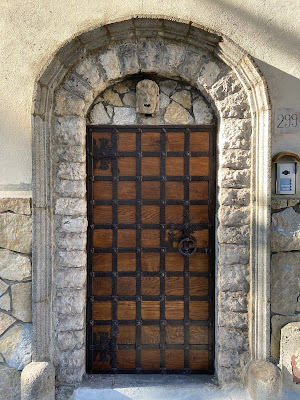In our series of blog posts titled the 40 Doors of Bergamo, we talked about architecture, living in Italy, the series The Ascent of Man, and psychogeography. It's the last idea that we'll expand on in this post. From Wikipedia: Psychogeography is the exploration of urban environments that emphasizes interpersonal connections to places and arbitrary routes and follows a loosely defined urban practice known as the dérive. This idea was in our minds as we wandered around Positano Italy for four days.
Positano is as vertical as it is horizontal. You go to Positano for its verticality, its sheer drops to the sea, its impossibility at the edge of the Mediterranean. We think as we climb the stairs one evening – we count 750 from the main beach to our B&B –what would it be like to live like this? The answer, probably quite fine. We would adapt and perhaps soon enough not think much of it. But for now, we are enjoying the newness of it all as we explore.
In Positano, the stairs are the only practical way to get around the city walking. From the stairs, the sea feels close at hand, so much so that you might literally tumble into it at any second with a false step.
One of the glimpses from the stairs of Positano is toward three islands in the distance, though they look like only one from Positano. These islands are called Li Galli, the "cocks", or officially as Le Sirenuse, referring to the sirens that were reported to have inhabited the islands. Rudolf Nureyev once owned the largest of the three island, Gallo Lungo. An easy-to-miss plaque at the main beach designates the main promenade fronting the beach as Passeggiata Rudolf Nureyev (1938 – 1993). With legs like his, he probably had less of an issue with the stairs of Positano than the average tourist.
Positano faces out onto the blue waters of the Gulf of Salerno, part of the Tyrrhenian Sea (bathing the west side of Italy), which is in turn part of the Mediterranean Sea. The Tyrrhenian Sea (Mar Tirreno in Italian) is named after what the Greek called the Etruscans, Tirreni, back in the 8th century A.D. The Sea of Etruscans is very blue today from Positano as geography and history come together.
Despite the presence of the sea nearby, it's surprising that access to it is by only two moderately sized beaches. In that sense, Positano is not your classic Italian beach town, with long stretches of sand. Nor does Positano have a harbor, a fact that puts it at a disadvantage with its Amalfi Coast neighbors.
The two Positano beaches, Fornillo and the main beach, called Positano Spiaggia, are your access to the water. A short, scenic walk connects the two beaches. On this cool, sunny March day, we see some swimming (Americans), but refrain from it ourselves with the excuse that we "aren't dressed correctly". Maybe we've become too Italian: swimming before the properly accepted season breaches an unspoken protocol.
We love towns like Positano because of the economical use of space. The radically terraced town has houses under and on top of cliffs, and houses stacked in stair-step patterns from sea to mountain. Yet, it doesn't feel crowded. The azure sea and the green Mediterranean macchia are always at hand. We only need lift our gaze, but only when we are not concentrating on the next step.
Steinbeck wrote in 1953 that "Positano bites deep. It is a dream place that isn’t quite real when you are there and becomes beckoningly real after you have gone." In 1956, Guy Debord put forward the concept of dérive, an unplanned journey through a landscape, usually urban, in which you drop everyday relations and let yourself be drawn by the attractions of the terrain and the encounters you find there. We couldn't think of a better way to experience Positano.





























































No comments:
Post a Comment
All comments are moderated. If your comment doesn't appear right away, it was likely accepted. Check back in a day if you asked a question.